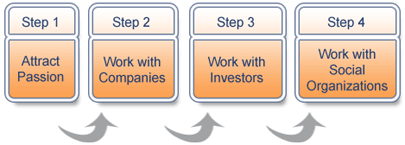SEC implements its own unique process of working with the different partners to achieve its goal of creating social and financial wealth and benefits.
The objective of having a clear process of operation for SEC to create a set of business activities. Together these activities will enable SEC to achieve its mission and vision in a self-sustaining profitable manner. The following figure outlines the process.

Step 1: SEC’s objective is to attract leaders from profit and non-profit sectors to join SEC’s goal of social wealth creation. By leveraging their expertise, capital and network, SEC has the vital resources to effectively implement its strategy.
Step 2: SEC actively seeks PLCs’ that have the greatest opportunities for SEC to increase their shareholder value. SEC will provide consulting and mentoring to PLCs’ in return for shares in the company. Due to its complexity and requirements of in-depth analysis, SEC will outsource the prospecting and researching function to Tulane University’s A. B. Freeman School of Business ir another university, whose renowned Reports will form a strong base for SEC’s quantitative and qualitative company research. SEC will also partner with management consultants to ensure the development of effective strategies for growth and value creation. SEC also works with private companies that have the potential to become profitable and have plans for public listing.
Step 3: SEC will have two types of relationships with investors:
1) Pure arms-length commercial relationships: In order to increase its revenue, SEC will offer value enhancement advice through outsourcing relationships with brokerages, mutual funds, and other professional investment management firms. The advice will be based on insight from ongoing consulting work with PLCs’. In exchange for the advice, corporate and private investors will agree to share a negotiated portion of their return on investment with SEC.
2) Interest-aligning relationships: As pointed out earlier in the discussion of SEC’s integrative strategy, companies and individuals working with SEC under outsourcing contracts will be encouraged to have a stake in the SEC business by investing either directly into SEC, or into SEC-consulted businesses. The objective here is to create a vested interest in the success of SEC.
Step 4: The SEC project is conceptualized as being part of a new wave of philanthropic enterprises in which traditional forms of donation and funding are replaced by more entrepreneurial forms of sustainable earned income. The new approach (SE) is best suited for non-profits struggling to find funding to support their initiatives. SE will enable these organizations to switch from the language of ‘funding’ to that of ‘financing.’ In other words, non-profits will adopt the cogent business logic of generating a sustainable revenue stream on their own, in excess of their financing costs. The outcome of which will be earned income left for investment into purely social projects.
